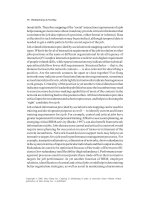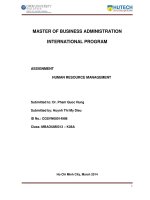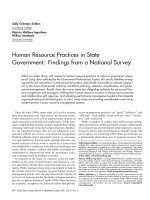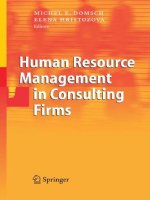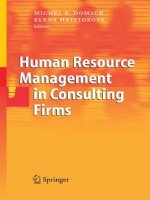Human resource management in district 11 public service limited company
Bạn đang xem bản rút gọn của tài liệu. Xem và tải ngay bản đầy đủ của tài liệu tại đây (1.47 MB, 54 trang )
HUMAN RESOURCE MANAGEMENT
IN DISTRICT 11 PUBLIC SERVICE
LIMITED COMPANY
CAPSTONE PROJECT REPORT
Ho Chi Minh City, 2013
Group No.: 3
LE NGUYEN NGOC SON
PHAM THI THU TRANG
CAO ANH THU
Class: GaBBA.SP0109
ANDREWS UNIVERSITY
GRIGGS UNIVERSITY
GLOBAL ADVANCED BACHELOR OF BUSINESS
ADMINISTRATION PROGRAM
CAPSTONE PROJECT REPORT
HUMAN RESOURCE MANAGEMENT IN DISTRICT 11
PUBLIC SERVICE LIMITED COMPANY
Group No.: 3
• LE NGUYEN NGOC SON
• PHAM THI THU TRANG
• CAO ANH THU
Advisor: Mr. VU THAI HA. MBA
Ho Chi Minh, 2013
Group 03_GaBBA.SP0109 i
Abstract
Currently, Vietnam has become a member of the World Trade Organization officially,
the legal mechanism are opening in the direction of creating a free competition market, strong
competition to win the new market, expand or protect the current market share. The private
enterprises will join the competition between them and the state enterprises in the market, or
competition between domestic enterprises and foreign enterprises. This competition takes place
in all industries and sectors. Therefore, the District 11 Public Service Limited Company is not
out of the rule.
Besides, the current market is a huge demand for sanitation services to ensure the maintenance
of buildings, green cleaning, especially the commercial building projects, the corporate office,
parks, senior housing. Thus, the supply market of sanitation services is great potential for the
companies involved.
However, to build a team has high qualification and ability to adopt a policy of effective human
resource management, the company need to identify the business development objectives in
their future, combined with develop the human resource department which can work
effectively. As a result, taking the policy on human resource planning, recruitment, training and
evaluation capability to find the right staff who meets the standard of the development
objectives of the company. Moreover, focusing on improving the operation of the department,
as well as coordinating activities between departments smoothly, assign clear responsibilities
and rights. Developing a job description and specific work standards apparently help the
employees in the company to understand their powers and duties, as well as the ability to reach
their future from which are capable promote the development of innovative companies in the
future. This capstone project addresses all these issues in District 11 Public Service Limited
Company ".
Group 03_GaBBA.SP0109 ii
Acknowledgement
This research project would not have been possible without the support of many people.
Firstly, we wish to express our sincere gratitude to Griggs University and National University
in Hanoi, Vietnam for providing us an opportunity to study and learn from GABBA program.
Secondly, we sincerely thank to our project advisor Mr. Vu Thai Ha for guidance and
encouragement in carrying out this project work.
Thirdly, we also wish to express our gratitude to the officials and other staff members of
“District 11 Public Service Limited Company " who rendered their help during the period of
our project work.
Moreover, our special thanks to Mr. Le Pham Duy Bao in the company for kind co-operation to
the completion of our project work.
Last but not least, we wish to avail our self of this opportunity, express a sense of
gratitude and love to our friends and our beloved parents for their manual support, strength,
help and for everything.
Group 03_GaBBA.SP0109 iii
Statement of Authorship
Except where reference is made in the text of the report,
This report contains no material unpublished elsewhere or extracted in hole.
All of the information is provided in the thesis is made by us.
No other person’s work has been used without
due acknowledgement in the main text of the thesis.
This has not been submitted for the award
of any degree of diploma in any other institution.
Date: 08
th
May, 2013
_________________________________________
Le Nguyen Ngoc Son
Pham Thi Thu Trang
Cao Anh Thu
Group 03_GaBBA.SP0109 iv
ORGANIZATIONAL CONTACT INFORMATION
- Company name : District 11 Public Service Limited Company
- English name : District 11 Public Service Company Limited
- Shortcut name : EPS Co.Ltd
- President : MR. Nguyen Thanh Liem
- Head Quater: 12, street 2, Lu Gia housing, ward 15 District11
- Phone: 0838662086 Fax : 0838662224
- Email :
- Account Number : 102010000171904
- Tax code : 0301148063
- Capital money of District 11 Public Service Limited Company : 34.035.000.000 VND.
- Project liaison name: Le Pham Duy Bao
- Project liaison title: Human Resource Management
- Project liaison phone: 0937343490
- Project liaison email:
Group 03_GaBBA.SP0109 v
TABLE OF CONTENTS
ABSTRACT i
ACKNOWLEDGEMENT ii
STATEMENT OF AUTHORSHIP iii
ORGANIZATIONAL CONTACT INFORMATION iv
TABLE OF CONTENTS v
LIST OF APPENDICES viii
CHAPTER 1: METHODOLOGY 1
Research design 1
CHAPTER 2: ORGANIZATION AND HUMAN RESOURCE DEPARTMENT
DESCRIPTION
1.1 Organization Description 2
1.1.1 Organization vision and mission 2
1.1.2 Organization history 2
1.1.3 Scope of Business 3
1.1.4 Organization Structure 3
1.1.5 SWOT analysis 4
2.1.5.1 Strengths 4
2.1.5.2 Weakness 5
2.1.5.3 Opportunities 5
2.1.5.4 Threats 6
2.2 Human Resource Department Description 7
2.2.1 Human Resource department function 7
2.2.2 Human Resource Department structure 7
2.2.3 Human Resource Department current working plan 8
2.2.3.1 Human Resource activities 8
2.2.3.2 Administration activities 8
Group 03_GaBBA.SP0109 vi
CHAPTER 3: LITERATURE REVIEW 9
3.1. The Brief Overview of Human Resources Management 9
3.1.1 Definition 9
3.1.2 Purposes 9
3.1.3 Functions 9
3.1.3.1 Planning and Recruiting 9
3.1.3.2 Training and Developing 9
3.1.3.3 Maintaining and Managing 10
3.1.3.4 The challenges for the current human resource management 10
3.2 Recruitment and Selection 10
3.2.1 Sources of recruiting 10
3.2.2 The factors affect the ability to attract staff of the organization 11
3.2.3 The factors limit the ability to attract candidates of the business 11
3.2.4 Hiring process 12
3.3 Performance Appraisal 12
3.3.1 Purposes 12
3.3.2 Measurement tools 12
3.3.3 Implementing assessment process 13
3.3.4 Appraisal Interview 13
3.4 Training and Developing 13
3.4.1 Purposes 13
3.4.2 Identifying training needs 13
3.4.3 Classifying the form of training 14
CHAPTER 4: DATA COLLECTION AND DATA ANALYSIS 15
4.1 Focus Group Interview 15
4.2 Data Collection 15
4.3 Data analysis 26
Group 03_GaBBA.SP0109 vii
CHAPTER 5: EVALUATING THE CURRENT STATUS OF HUMAN RESOURCE OF
THE COMPANY 17
5.1 Evaluating Current Human Resource 17
5.2 Evaluating the Current Recruitment 18
5.3 Evaluating the Current Performance appraisal 20
5.3.1 In case of evaluating the ability of employee 20
5.3.2 In case of evaluating the competition between department and department 20
5.4 Evaluating the current training and development 20
CHAPTER 6: RECOMMENDATION TO IMPROVE HUMAN RESOURCE
MANAGEMENT 22
6.1 Reorganizing the Human Resource Department 22
6.2 Building Recruitment Polices 25
6.3 Creating Performance Appraisal System 26
6.4 Opening Training and Development Programs 29
IMPLICATION AND FURTHER STUDY OPPORTUNITY 33
REFERENCES 34
APPENDICES 35
Group 03_GaBBA.SP0109 viii
LIST OF APPENDICES
A. VIETNAMESE DATA
- Recruitment Polices
B. ENGLISH DATA:
- Organization history
- Organization Structure
- Interview Raw Data
Group 03_GaBAA.SP0109 1
CHAPTER 1: METHODOLOGY
Understanding the human resource management process of District 11 Public Service
Limited Company through analysis of current HR policies such as:
Policymaking, and human resources forecast.
The process of job analyzes.
The policies recruit personnel.
The policies human resources evaluated.
Regulation of other departments and role of administration department
Thematic are studied through analytical methods, observation in the workplace, and
organization chart of the company. The information gathered in period of probation is mass
up operation regulations departments, HR policies related to the planning, recruitment,
training, staff competency assessments. Since then could make comments and arguments on
HR activities management. Through which offer recommendations to overcome these
disadvantages longer exist.
Research design:
Report consists six chapters, 30 pages length. And focus to research about 4 main
aspects: Human Resource, Recruitment, Performance Appraisal and the training and
development programs in District 11 Public Servie limited company.
The chapters:
Chapter 1: Methodology
Chapter 2: Organization Discription
Chapter 3: Literature Review
Chapter 4: Data Collection and Data Analysis
Chapter 5: Evaluating the Current Status of the Company
Chapter 6: Recommendation to Improve Human Resource Management in the Company
Group 03_GaBAA.SP0109 2
CHAPTER 2: ORGANIZATION AND HUMAN RESOURCE DEPARTMENT
DESCRIPTION
2.1 Organization Descriptions
2.1.1 Organization vision and mission
Vision:
Short - term:
The company focuses on expanding hygiene service-supplying-model for outside
units, aiming at revenue growth and interest as well as capability of transporting waste.
Long – term:
In the long-term visions, the company tries to improve the training for the potential
staffs. Besides, apply the information technology field to the company’s activities. The last
which is the most important vision is becoming one of the largest and most successful
companies in its industry and expanding the markets.
Mission:
Public contributions are the company’s strength. Its main activity is to strengthen
continually socially useful activities.
In order to acquire this mission, the company has to study and remain active in some new
types such as: studying investment projects and taking advantage of public transport; and
investing in the construction of maintaining parks as well as green grasses in district 11.
2.1.2 Organization history
The company was established and invested by the government. The Enterprise of urban
transport work in district 11 was the predecessor of the company. Company was formed from
three teams: Hygiene cleaning team, the traffic works team and the Public Works team. The
main activities are public Hygiene, building, repair works traffic and urban projects. After
many change in company’s duty, scope of business and name, it has been changed into the
Public Service Limited Company of District 11 recently. (More detail in the APPENDICE)
Group 03_GaBAA.SP0109 3
2.1.3 Scope of Business
Environment and Public contribution activities
The Public Service Limited Company of District 11 is the state-owned company, which
has public interest in activities and many other business careers in the construction field as
main functions and is directly under the guidance of HCMC people’s committe. In order to
work in:
- Managing, improving and building many traffic and urban projects.
- Collecting and transporting garbage; ensuring urban area hygiene.
- Managing, hiring state-owned houses out on current regulations.
2.1.4 Organization Structure
Structure of Organization is divided into 3 main lines according to 3 functions: technical,
planning, human resource and each line is controled by a vice president. They support each
other and report everything to the president. [More information in the (Appendices, A, 2)]
Group 03_GaBAA.SP0109 4
2.1.5 SWOT analysis
2.1.5.1 Strengths
Its competitive ability in the industry:
The public service aims at serving demands of caring and cleaning for public projects
and all people, so the company seems to have no competitor. It only bid for supplying the
hygiene service for managing organs in its area.
However, the company must face many big competitors because it also supplies services for
private clients. Unlike the state-owned-companies, the company is not under control of the
law, it does not pay tax and its dispute solving does not based on the law, leading to many
difficulties for the company.
Group 03_GaBAA.SP0109 5
The company’s key strength is human resource:
The staffs are professional level and good experience. They can understand and deal
with problems quickly. Moreover, they are able to transmit their experience to the young.
They work together in unity, so it is easier for them to reach decisions.
2.1.5.2 Weakness
The ability to attract human resource with high level:
There are still some limitations to improve. The working environment has not been
modern and democratic yet; the salary ranges has had some problems; the staff’s promotion
policy have not been attractive; the company’s recruitment is internal and it is usually through
introduction.
Competitive ability about personnel:
The more developed country is, the higher level workers become so that the public
service is not considered as an important industry and salary policy is not attractive, leading to
limitation on attracting workers.
Toward workers with high knowledge, recruitment demand is not high and public, promotion
ability and working environment is not attractive, so it is difficult to attract good staff
compared to other fields. Finally, the company’s labor recruitment faces lots of challenges.
Culture:
The company’s culture is also an important aspect. It has not built a specific culture
yet and been strongly affected by family feature for solving problems. Therefore, the
company has not created a strong link between offices and departments as well as an active
working environment. It needs to plan clearly to develop easily in the future and build
particular personnel plans.
2.1.5.3 Opportunities
Group 03_GaBAA.SP0109 6
Technology:
In the past years, information technology has greatly developed from using separate
computers to using the computer systems integrated with enterprise resource planning (ERP),
which changes thoroughly the company’s management method. If deploying promptly the
system of human resource management through many information technology solutions, the
company will take lots of advantages in management and competition.
Customers – the units demand hygiene services:
Customers who can flexibly apply price level and make high profits for the company.
The company’s price, however, is usually higher than competitive rivals – the private
organizations because the restriction of operation areas and the bounds of regulations.
2.1.5.4 Threats
The labor market:
To meet economic development targets in 2011, the city is forecast to need about
265,000 workers. In which, blue – collar workers account for over 45%, white- collar ones is
about 20% and about 45% belongs to intermediate labor. However, the market only meets
about 50 – 60%.
The scarce labor in the market will affect the company’s plan of human resource development
especially the demand of blue - collar worker recruitment. Besides, it is very difficult to
attract many good managers because the company has to meet their high demands. The
company is the state – owned enterprise, so salary ranges must comply with the pay grade
system and positions that the government fixed. Therefore, it is not easy to build the
interesting salary ranges in order to attract the talented people for the company.
Economic factor:
The high inflation affects the people’s lives because of price increase. That also
greatly influences the company due to the pressure of salary increase for workers and officers.
Although the performance expansion of many service contracts of hygiene, green trees and
water supplying will create more its turnover and interests, the company also faces lots of
Group 03_GaBAA.SP0109 7
difficulties because many partners will suggest reducing prices or stopping services to
cooperate with other private units with cheaper prices.
The law regulations:
Like other state- owned- companies, most activities of the company are directly under
the control of the state’s regulations. Therefore, it is so difficult to build a good manager
group. The organization structure building and operation regulations like recruitment,
working regulations and group management need to be passed by the state organs.
Besides, the company uses the legal regulations to change operation methods from the state –
owned company into the limited company in organizing and arranging human resource
system in order to appropriate for new operation forms.
Furthermore, spending decrease, budget saving as well as compulsive costs of the
environmental protection and hygiene also affect the company’s operation. The increase of
service costs have made customers not satisfied and reduced its competition in the market.
2.2 Human Resource Department Description
2.2.1 Human Resource department function :
According to directorate’s decision, Human Resources Department is responsible for
recruiting, organizing staffs, and in charge of clerical work, making health insurance card,
observing apartment buildings’ activities.
2.2.2 Human Resource Department structure:
There are 5 members in this department and the manager decides every work
according to Human Resource by the report of vice manager.
Group 03_GaBAA.SP0109 8
2.2.3 Human Resource Department current working plan:
Undertaking organization of assignments and managing administrative assignments.
2.2.3.1 Human Resource activities:
The Human Resource department has responsibilities for recruiting and organizing
human resource according to decision of the board of directors. Particularly, they are
responsible for documentation of assignments, registering social insurance and medical,
monitoring operation of tenants.
2.2.3.2 Administration activities:
There are three main activities. Firstly, the administration activities are managing the
company seal; receiving and transporting official documents; saving files and arranging
meeting schedules, including vehicles for tasks and protocols. Secondly, they also have
responsibilities for security keeping, combustion prevention, hygiene and environmental
landscape. Finally, they offer suggestions for the board of directors to repairing and buying
properties and equipment to serve office administrative assignments; preparing instruments
and labor safety uniforms for workers.
Group 03_GaBAA.SP0109 9
CHAPTER 3: LITERATURE REVIEW
3.1. The Brief Overview of Human Resources Management
3.1.1 Definition:
The human resource management is the process “which consists of eight activities
necessary for staffing the organization and sustaining high employee performance” (Stephen
P. Robbins, Marry Coulter, Management 353). The first three activities ensure that competent
employees are identified and selected; the next two involve providing employees with up-to-
date knowledge and skills; and the final three ensure that the organization retains competent
and high performing employees.
3.1.2 Purposes:
Some of the overall purposes of human resources management are to ensure that all
employees perform their duties to promote the goals of the company. Also, human resources
are responsible for taking the full advantage of the capabilities of the employees and placing
the right employees in the right job positions. ()
3.1.3 Functions:
Human resource management is responsible for:
3.1.3.1 Planning and Recruiting
HR planning is the process by which managers “ensure that they have the right
number and kinds of capable people in the right places and at the right times” (Stephen P.
Robbins, Marry Coulter, Management 356). Through planning, organizations can avoid
sudden talent shortages and surpluses. And recruitment is locating, identifying and attracting
capable applications.
3.1.3.2 Training and Developing
Training and developing are an important human resource management activity. As
job demands change, employee skills have to change. This is the process that provides
employees specific skills, or helps those correct deficiencies in performance.
()
Group 03_GaBAA.SP0109 10
3.1.3.3 Maintaining and Managing
After hiring the right people and training them, the HR department needs to maintain
and manage them. This process includes the following contents: orientation, transfer,
promotion; guidance and counseling; evaluation and performance management work;
motivate, reward and build teamwork good; manage the termination process.
()
3.1.4 The challenges for the current human resource management
There are three types of HR challenges facing managers today. Firstly, it is an
environmental challenge. It included the external forces like rapid change, the internet
revolution, workforce diversity, globalization, legislation, evolving work and family roles,
skill shortages, rise of the service sector, natural disasters It influences organizational
performanceand largely beyond management’s control. So managers need to monitor the
external environment for opportunities and threats. Secondly, it is an organizational challenge.
It included the internal forces such as competitive position, decentralization, downsizing,
organizational restructuring, self-managed work teams, the growth of small businesses,
organizational culture, internal and data security It is important for firms to be proactive, to
take action before problems get out of hand and it can be done only by managers who are well
informed about important HR issues and organizational challenges. Lastly, it is an individual
challenge. It can be matching people and organizations, ethics and social responsibility,
productivity, empowerment, brain drain, job insecurity deal with decisions pertinent to
specific employee It almost always reflects what is happening in the larger organization and
how the company treats its individual employees is also likely to affect the organizational
challenges discussed. ()
3.2 Recruitment and Selection
3.2.1 Sources of recruiting
According to Dr. Trần Kim Dung (2006, Quản trị nguồn nhân lực, Nxb Thống Kê, TP
Hồ Chí Minh), there are two kinds of recruitment sources. The first one is internal sources,
which are primarily three - transfers, promotions and Re-employment of ex-employees. Re-
employment of ex-employees is one of the internal sources of recruitment in which employees
Group 03_GaBAA.SP0109 11
can be invited and appointed to fill vacancies in the concern. There are situations when ex-
employees provide unsolicited applications also. Internal recruitment may lead to increase in
employee’s productivity as their motivation level increases. It also saves time, money and
efforts.
The second one is external sources which have to be solicited from outside the
organization. External sources are external to a concern. But it involves lot of time and
money. The external sources of recruitment include - Print and radio advertisements which
can be used for local recruitment efforts (e.g. newspapers) and for targeted regional, national,
or international searches; Internet advertising and career sites which are relatively cheap,
more dynamic & often produce faster results than newspaper help-wanted ads; employment
agencies are certain professional organizations which look towards recruitment and
employment of people. Many organizations use external contractors to recruit and screen
applicants for a position. The staffing firm is paid a fee based on the salary offered to the new
employee. It can be particularly effective when the firm is looking for employees with a
specialized skills; college recruiting includes company visits to college campuses, job fairs,
and relationships such as internships. It is value in interacting with college students,
developing relationships, and generating interest in the college pool of candidates;
recommendations are certain people who have experience in a particular area. They enjoy
goodwill and a stand in the company. There are certain vacancies which are filled by
recommendations of such people etc.
3.2.2 The factors affect the ability to attract staff of the organization
There are two main factors can affect the ability to attract staff of the organization.
The first factor is internal factors which can be included the requirement- attraction of work
like working condition, salary, promotion, etc.; or the image of the organization like the
reputation, scope of business, brand, etc. The second one is external factors which can be
included economic trend, unemployed workers rate ()
3.2.3 The factors limit the ability to attract candidates of the business
There are some factors limits the ability to attract candidates. Firstly, the job is not
attractive. The job is considered boring, low-income, less promotion opportunities, dangerous,
low social position, etc will be difficult to attract qualified candidates. Secondly, the business
Group 03_GaBAA.SP0109 12
is not attractive. Although candidates interested in the job but they did not like the type, name,
policies, economic sectors, reputation and prospects of the business. The business was
underestimated by candidates often have less applicants and it is difficult to attract good
candidates. ()
3.2.4 Hiring process
There are three steps in hiring process. Step 1 is recruitment. This is the process of
generating a pool of qualified candidates for a particular job. Step 2 is selection. This is the
process of making a “hire” or “no hire” decision about each applicant for a job. Step 3 is
socialization that orients new employees to the organization and to the units in which they
will be working. ()
3.3 Performance Appraisal
3.3.1 Purposes
The purpose of the performance appraisal is to provide feedback on an employee's
performance, to create a development plan for areas of improvement and to provide rationale
for a merit increase (Luis R. Gómez – Mejia, David B. Balkin, Robert L. Cardy, Managing
Human Resources). Taken together, an employee's performance appraisals can provide the
basis for a promotion.
3.3.2 Measurement tools
Measurement tools can be classified in two ways. Firstly, the type of judgment that is
required such as relative or absolute. Relative judgment system is an appraisal format that
asks supervisors to compare an employee’s performance to the performance of other
employees doing the same job. Absolute judgment system is an appraisal format that asks
supervision to make judgments about an employee’s performance based solely on
performance standards.
Secondly, the focusing of the measure is trait, behavior, or outcome. Trait appraisal
instruments are an appraisal tool that asks a supervisor to make judgments about worker
characteristics that tend to be consistent and enduring. Behavioral appraisal is an appraisal
tool that asks managers to assess a worker’s behaviors. Outcome appraisal is an appraisal tool
that asks managers to assess the results achieved by workers. ()
Group 03_GaBAA.SP0109 13
3.3.3 Implementing assessment process
There are three steps in the performance appraisal. Step one is identification. This step
will determine what areas of work the manager should be examining when measuring
performance. Step two is measurement. This step will make managerial judgments of how
“good” or “bad” employee performance was. Step 3 is management. In this step, the goal of
any appraisal system will be overridden.( )
3.3.4 Appraisal Interview
After completing the performance rating the supervisor usually conducts an interview
with the worker to provide feedback. It is one of the most important parts of the appraisal
process. Many managers dread the performance appraisal, particularly if they do not have
good news. The HR department can help managers by offering training in conducting
interviews, providing role-play practice, and offering advice on thorny issues.
Performance reviews are sometimes separated into two sessions: one to discuss
performance and the other to discuss salary but, research supports doing them together: the
salary discussion in an appraisal session has a positive impact on how employees perceive the
appraisal’s usefulness (Luis R. Gómez – Mejia, David B. Balkin, Robert L. Cardy, Managing
Human Resources).
3.4 Training and Developing
3.4.1 Purposes
Training often is considered for new employees only. It is an activity which is done in
order to increase the employees experience in one more skills, or help correct deficiencies in
performance. Also, training for current employees helps them adjust to rapidly changing job
requirements. Enhancing the company's ability to adopt and use advances in technology
because of a sufficiently knowledgeable staff. ()
3.4.2 Identifying training needs
There are three level of training needs. The first level is organizational analysis. It
examines broad factors such as organization’s culture, mission, business climate, long- &
Group 03_GaBAA.SP0109 14
short-term goals, and structure The second level is task analysis which is an examination of
the job to be performed based on job analysis. It used to identify KSAs (Knowledge, Skills,
and Abilities) required to perform the job adequately. Also, KSAs are used to determine the
kinds of training needed. The last level is person analysis. It determines which employees
need training and examine how well employees carry out tasks that make up their jobs.
()
3.4.3 Classifying the form of training
In reality, there are many types of training. But they were divided into two groups. The
first group is general training. It includes communication skills, computer systems application
and programming, customer services, executive development, management skills and
development, personal growth, sales, supervisory skills, technological skills and knowledge
The second group is specific training. It includes basic life/works skills, creativity,
customer education, diversity/cultural awareness, remedial writing, managing change,
leadership, product knowledge, public speaking/presentation skills, safety, ethics, sexual
harassment, team building, wellness and others. ()
Group 03_GaBAA.SP0109 15
CHAPTER 4: DATA COLLECTION AND DATA ANALYSIS
4.1 Focus Group Interview:
We operate a small focus group interview to analyze the thinking of employee in the
company about Human Resource, Recruitment, Performance Appraisal and Training and
Development Process. The targets we choose are 5 employees in 5 departments (Planning,
Human Resource, Accounting, Technical, House management) of the company and they will
be asked 4 questions:
-Question 1: What do you think about the Human Resource in the company?
-Question 2: What do you think about the Recruitment in the company?
-Question 3: What do you think about the Performance Appraisal in the company?
-Question 4: What do you think about the Training and Development Process in the
company?
4.2 Data Collection
Keyworks answered by 5 employees in 5 deparments (analyzed according to the
Interview Raw Data in the Appendices):
Question 1:
-Most of employees said that: I think that average age og the employee is high so that they
would be retired soon and the company will be lacked of appropriate human resource to run
the business
-A few employees said that: I think it is ok and adapts every requirement.
Question 2:
-Most of employees said that: they are not fit with their job now. The scope of Recruitment of
company is so limited so company could not have more selection so that the standard of
Recruitment was not high enough. And most of new employee had to be retraining a lot
before working.



